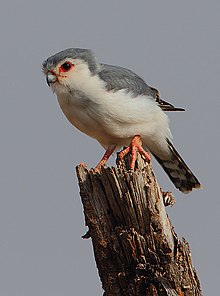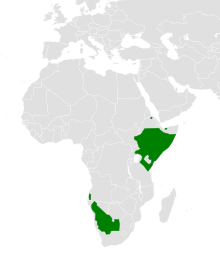Pygmy falcon
| Pygmy falcon | |
|---|---|

| |
| Male in Buffalo Springs National Park, Kenya | |
| Scientific classification | |
| Kingdom: | |
| Phylum: | |
| Class: | |
| Order: | |
| Family: | |
| Genus: | |
| Species: | P. semitorquatus
|
| Binomial name | |
| Polihierax semitorquatus (Smith, 1836)
| |

| |
| Pink: Vagrant in Rwanda | |
The pygmy falcon, or African pygmy falcon (Polihierax semitorquatus), is a falcon that lives in eastern and southern Africa and is the smallest raptor on the continent. As a small falcon, only 19 to 20 cm long, it preys on insects, small reptiles, and small mammals.
Description
Adult pygmy falcons are white below and on the face, grey above, and females having a chestnut back. There are white "eye spots" on the nape. Juveniles have a brown back, duller than adult females, with a rufous wash on the breast. The flight feathers of the wings are spotted black and white (more black above, more white below); the tail is barred black and white.[2][3]
The flight is low and undulating. In size, pattern, and the habit of perching upright on an exposed branch or treetop, this species resembles some shrikes.[2][3]
The call is "a high-pitched kikiKIK, repeated" (Kenya)[2] or "a 'chip-chip' and a 'kik-kik-kik-kik'" (southern Africa).[3]
Range, habitat, and population
The pygmy falcon inhabits dry bush. The subspecies P. s. castanonotus occurs from South Sudan to Somalia and south to Uganda and Tanzania; P. s. semitorquatus occurs from Angola to northern South Africa.[1][3] This range is estimated to have an area of 2.7 million km2, and the total population is estimated to be between 100,000 and 1 million birds.[1]
Nesting

In Kenya, pygmy falcons nest in white-headed buffalo weaver nests, and the ranges of the two birds coincide.[2] In southern Africa, they are found around red-billed buffalo weaver nests but predominantly nest in the vacant rooms of sociable weaver nests,[3] which are large and multichambered—even if the sociable weavers still have an active colony in the nest. Despite being bird-eaters and bigger than sociable weavers, the pygmy falcons largely leave the latter alone, though they do occasionally catch and eat nestlings and even adults.[4]
Polyandry
Pygmy falcons occasionally engage in polyandrous relationships, where there are more than two adults living together and tending nestlings. There are four potential reasons for this behaviour: defence, co-operative polyandry, delayed dispersal of offspring, and thermoregulation (warmth). Corroboration for the last is that in winter African pygmy falcons nest further inside the nest of sociable weavers, where there is better insulation.[5]
References
- ^ a b c Template:IUCN
- ^ a b c d Zimmerman, Dale A.; Turner, Donald A.; and Pearson, David J. (1999). Birds of Kenya and Northern Tanzania. Princeton University Press. pp. 90–91, 110–111, 309. ISBN 0-691-01022-6. Retrieved 2007-07-26.
{{cite book}}: CS1 maint: multiple names: authors list (link) - ^ a b c d e Sinclair, Ian; Hockey, Phil; and Tarboton, Warwick (2002). Birds of Southern Africa. Princeton University Press. pp. 116, 132. ISBN 0-691-09682-1. Retrieved 2007-07-26.
{{cite book}}: CS1 maint: multiple names: authors list (link) - ^ Covas, Rita; Huyser, Onno; and Doutrelant, Claire (2004). "Pygmy Falcon predation of nestlings of their obligate host, the Sociable Weaver". Ostrich. 75 (4): 325–326. doi:10.2989/00306520409485463. ISSN 0030-6525.
{{cite journal}}: CS1 maint: multiple names: authors list (link) - ^ Spottiswoode, Claire; Herrmann, Eric; Rasa, O. Anne E.; and Sapsford, Colin W. (2004). "Co-operative breeding in the Pygmy Falcon Polihierax semitorquatus". Ostrich. 75 (4): 322–324. doi:10.2989/00306520409485462. ISSN 0030-6525.
{{cite journal}}: CS1 maint: multiple names: authors list (link)
External links
- Pygmy Falcon - Species text in The Atlas of Southern African Birds.
- Birds Of Prey

